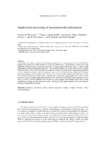Graph-based processing of macromolecular information

Ver/
Use este enlace para citar
http://hdl.handle.net/2183/17768Coleccións
- GI-RNASA - Artigos [195]
Metadatos
Mostrar o rexistro completo do ítemTítulo
Graph-based processing of macromolecular informationAutor(es)
Data
2015Cita bibliográfica
Muneanu CR, Aguiar-Pulido V, Freire A, et al. Graph-based processing of macromolecular information. Curr Bioinform. 2015;11(5):606-631
Resumo
[Abstract] The complex information encoded into the element connectivity of a system gives rise to the possibility of graphical processing of divisible systems by using the Graph theory. An application in this sense is the quantitative characterization of molecule topologies of drugs, proteins and nucleic acids, in order to build mathematical models as Quantitative Structure - Activity Relationships between the molecules and a specific biological activity. These types of models can predict new drugs, molecular targets and molecular properties of new molecular structures with an important impact on the Drug Discovery, Medicinal Chemistry, Molecular Diagnosis, and Treatment. The current review is focused on the mathematical methods to encode the connectivity information in three types of graphs such as star graphs, spiral graphs and contact networks and three in-house scientific applications dedicated to the calculation of molecular graph topological indices such as S2SNet, CULSPIN and MInD-Prot. In addition, some examples are presented, such as results of this methodology on drugs, proteins and nucleic acids, including the Web implementation of the best molecular prediction models based on graphs.
Palabras chave
Markov descriptors
Molecular information
QSAR
Complex networks
Graphs
Protein topological indices
Molecular information
QSAR
Complex networks
Graphs
Protein topological indices
Versión do editor
Dereitos
The published manuscript is avaliable at EurekaSelect
ISSN
2212-392X
1574-8936
1574-8936





